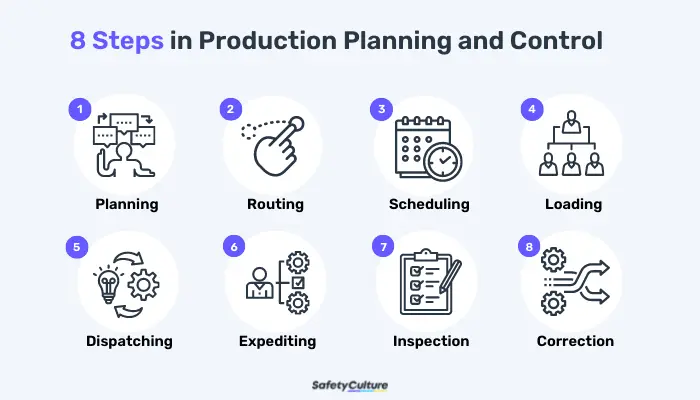What is Production Planning and Control?
Production planning and control refers to the two separate pre-production stages of manufacturing: production planning and production control. It’s the process of managing the resources, manpower, schedules, and other aspects of producing goods and services. Production planning and control is implemented by businesses to further strengthen their production process and prevent setbacks from affecting their normal operations.
Benefits
As a best practice for quality assurance and quality control, the main goal of production planning and control is to maximize the materials, workforce, productivity time, and other resources used in the process of manufacturing. With this technique, production managers also primarily aim to ensure that production results are according to set quality, quantity, and schedule. See below for other benefits of implementing production planning and control in your organization:
- Enhance material procurement – As a way to improve the procurement process, better communication with suppliers and other third-party vendors at the planning stage helps lead to accurate sourcing and allocation of materials.
- Improve production time – Proactively identify if there would be challenges, bottlenecks, or causes of production delays ahead of time. Greater visibility in the production process helps teams promptly meet production schedules and demands.
- Reduce production costs – With a well-planned and constantly-monitored production, businesses can utilize their resources efficiently and effectively. Lessen production costs to their ideal level while still ensuring that the quality of goods and services is not compromised.
- Minimize resource waste – Maintain inventory at optimal levels with the execution of strong production planning and control. Avoid discrepancies between material supply and material demand to avoid waste of resources.
- Streamline production process – When production managers and team members follow a standardized approach in the production process, it’s easier to spot inefficiencies, prevent production delays, and identify further opportunities for growth.
8 Steps in Production Planning and Control
For smooth-running integration of production planning and control, businesses should implement a systematic routine that is proven to be effective. Production managers should also emphasize the importance of following the established process from end to end to ensure that everyone involved in the production contributes to the success of the operation.
Combined steps of production planning and production control complete the steps involved in the whole process of production planning and control. These can be modified according to the specific needs of a business, but the most commonly-used sequence is the following:

1. Planning
As the first step of the process, planning states all the materials, manpower, manufacturing techniques, resources, and other initial details needed to complete the production. If there are specific instructions from other business units, they should also be noted at this stage.
This helps strengthen the production approach from the beginning to avoid misuse of resources or miscommunication in manufacturing schedules.
2. Routing
Routing determines the path of goods starting from raw materials up to finished products. It specifies the most efficient sequence of the operations and also identifies the machines to be used in each step of production.
Routing ensures that the process is continuous by indicating whether a machine is unavailable, or if there are other bottlenecks in the production.
3. Scheduling
As the time element of production planning and control—scheduling states all the production elements that are related to timing or schedules. Scheduling should assist in arranging the manufacturing steps in order of priority and ideally include the start and end times of each production task.
Businesses can utilize various types of scheduling practices such as master schedules, operation schedules, or daily schedules to further organize their production process.
4. Loading
Loading, as defined in the manufacturing aspect, is the process of determining the ideal allocation of workload to employees and to machines used, in accordance with their capacity.
Loading enables businesses to identify if there are potential manpower shortages or challenges in any of the workstations. With loading, you can implement proactive measures that can prevent these bottlenecks from negatively impacting productivity.
5. Dispatching
Dispatching is the implementation of all the plans stated in the previously mentioned steps, into actual production. It can be classified as either centralized—where orders are provided by a specific authority; or decentralized—where instructions are issued by all involved business units.
6. Expediting
Also known as follow-up, expediting is designed to evaluate the effectiveness of the whole production process. The main goal of expediting is to compare the initial plans against the actual result of productions.
This step can also be an opportunity to spot inefficiencies in the processes or determine whether any of the production tasks can still be improved.
7. Inspection
Similar to expediting or follow-up, inspection is an extra step performed to ensure that all the planning and controlling approaches identified by the management are consistently implemented and adhered to.
Regular or random inspections also help strengthen the reputation of businesses by guaranteeing the quality of goods and services produced by the company.
8. Correction
Once the above-mentioned steps are performed and there are issues or areas for improvement that were identified, this is the step where they can be modified. Correction enables businesses to further enhance their production process and implement planning and control techniques in a more efficient manner.




